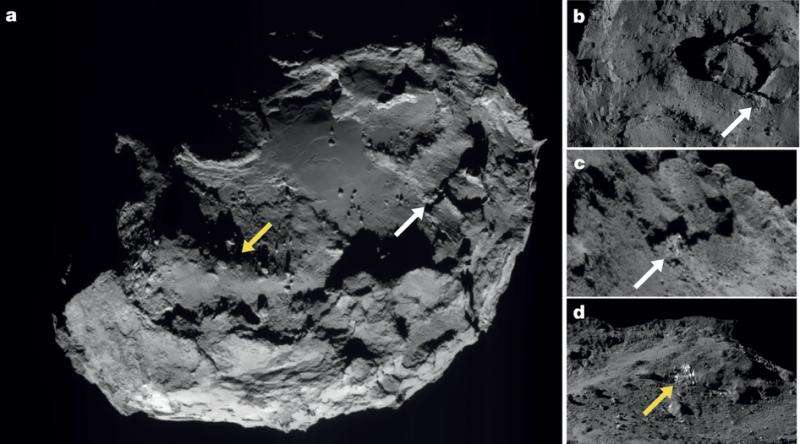
Water Ice Found On The Surface Of Comet 67P By Researchers
The European Space Agency’s Rosetta space probe has discovered water ice on the outer surface of a comet 67P, a new discovery which sheds light on the evolution of comets. The elusive ice was detected by Rosetta Orbiter on the bottom part of the main lobe of the dumbbell-shaped comet, in a region called Imhotep.

Researchers, including one of Indian-origin, have identified two large patches of water ice on the surface of comet 67P. It appeared as noticeably bright patches in visible light and was located on cliff walls and debris falls, researchers said. The patches contain a dry, crunchy coating over the ice-layered core in the bottom part of the main lobe of the dumbbell-shaped comet 67P/Churyumov-Gerasimenko, in the region also known as Imhotep.
“It looked like there was a breakage, or something fell down on the surface of the comet, and a large, new inside area that had water ice was exposed,” said the Indian-origin team member Murthy Gudipati from the Jet Propulsion Laboratory in California.
Like most comets, the surface of 67P, is mainly covered by materials that are so dark they appear almost black. The main reason of the black visibility is the constant movement of the comet towards the Sun and is exposed to the warmer temperatures that make the ice to sublimate and start transforming directly from their solid nature to gas.
Data collected by Rosetta’s Visible Infrared and Thermal Imaging Spectrometer (VIRTIS) showed that the water ice grains in the Imhotep region came in two different sizes. Some of the grains were tiny, just tens of micrometres across which were probably formed as a result of the comet’s 12-hour rotation.
On the basis of the scans performed by the researchers between the months of September and November 2014, there are two areas that have been identified, tens of meters across in Imhotep region appearing as bright patches include a particular amount of water ice in them, Murthy Gudipati stated.
The researchers explained that the large grains of water ice in two separate locations on the surface of the comet were created when the sun’s heat vaporized the water ice found under the comet’s dust. The water ice may have recondensed and did not leave the surface of the comet.
“If the thin ice-rich layers that we see exposed close to the surface are the result of the comet’s activity, then they represent its evolution, and it does not necessarily require global layering to have occurred early in the comet’s formation history,” Gianrico Filacchion, lead author of the study said in a statement.
The findings were published in the online journal, Nature.